617 Search Results for tell me about it
April 20, 2013
by Carole Zangari -
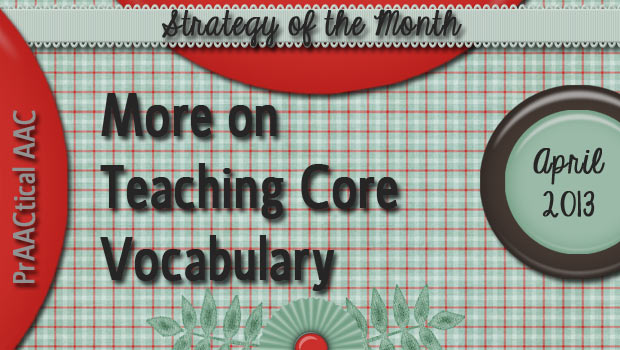
Last week, we talked about two key strategies for teaching core language: using aided language input and creating frequent opportunities to teach and elicit core words. In today’s post, we’ll expand the number of words and discuss two additional considerations for teaching core words. Aided language input is always important in working with beginning users of AAC. It exposes them to their new means of communication, provides them with a competent model of their AAC system, and introduces them to words and symbols they don’t yet know within a meaningful context. It also forces us to slow down when talking, something that can be very beneficial when you consider that many beginning users of AAC also have difficulty processing oral language. (It may take them longer to decode what they’re hearing and they may have to concentrate more than the average kid.) If you’ve actually tried pointing to symbols as... [Read More...]
April 19, 2013
by Carole Zangari -
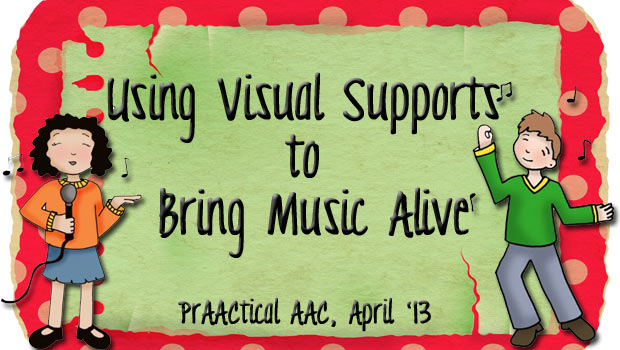
When I first met our guest blogger almost 20 years ago, she was using more visual supports in her music therapy sessions with kids who had ASD than most SLPs were using in their language therapy. Marlene Sotelo has worn many hats in her professional life, but her passion for helping people with ASD communicate more effectively seems to have permeated all of them. In this post, she discusses some of the ways she uses visual supports to help make music therapy effective. Music is a powerful force that transcends time, cultures, and languages. It can transport you to the past, and bring you hope and excitement for the future. In addition, music can be an effective tool in teaching children with varying abilities. The predictability, rhythmic patterns, and repetitive nature of the structure music lends itself to the development of language, cognitive skills, and motor skills, especially for individuals... [Read More...]
April 18, 2013
by Carole Zangari -

We’re back again with another AACtual Therapy post from SLP Shareka Bentham. We love the way she creates ‘buy in’ with kids, families, and teachers with this terrific activity. Everyone who knows me knows that I can get a little bit crazy sometimes, so when I went around school informing the teachers that we were going to be doing a school-wide Harlem Shake, no one was surprised. The thing is, my little ones, especially the school aged children are all very aware of the latest trends in popular culture (I have a little one that will only use his Big Mack to request Adele). Whether they are verbal or nonverbal, they can show you all the latest moves. So we just had to do Harlem shake. Well, a modified version… The main focus of the activity was making using AAC to make choices for the dress-up part of the activity.... [Read More...]
April 13, 2013
by Robin Parker -
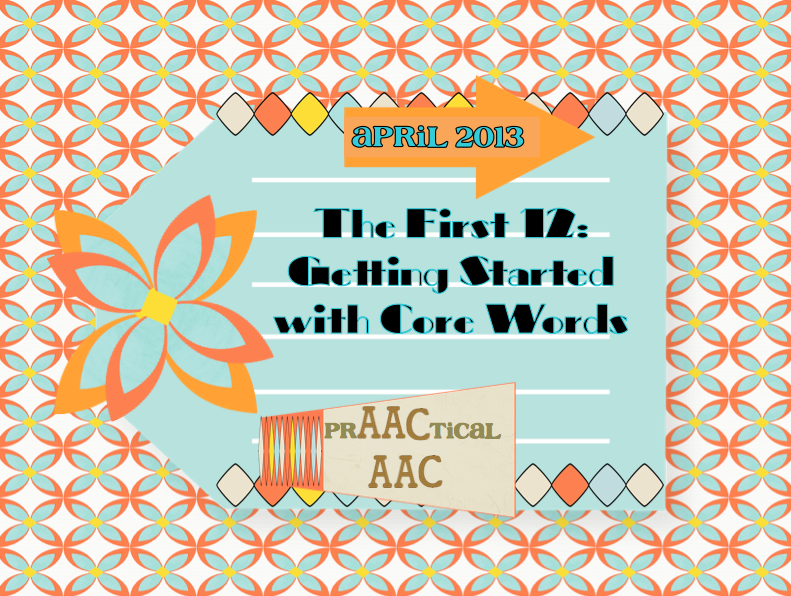
The focus this month is on core word vocabulary and effective teaching strategies. Most core vocabulary is represented through abstract symbols that range from translucent (i.e., makes sense after it is explained) to opaque (i.e., doesn’t have any resemblance to the word or concept) which makes the need for effective teaching all the more important. It also makes it more fun because meaningful language experiences, emotional language experiences, and repetition with variety experiences are going to be the platform for teaching. Within the platform of authentic language experiences, layers of teaching strategies can be applied. The more strategies we apply to learning, the more we assure ALL learners will benefit from our teaching. Core word vocabulary teaching begins with a few premises that underlie the process. These are not new ideas but ones that should be reaffirmed as you begin teaching. It is important, as always, to presume competence. All learners... [Read More...]
April 12, 2013
by Carole Zangari -
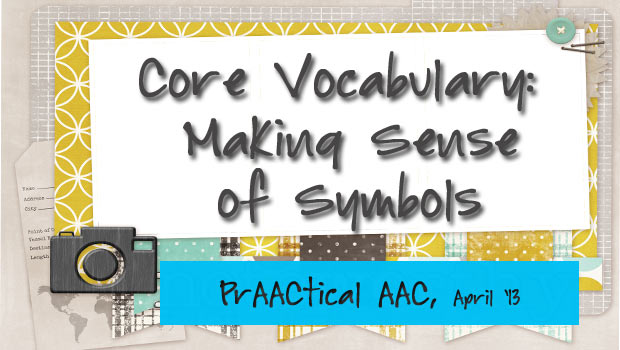
Take a look at these pictures and try to guess their meanings. Now do it again with these symbols. One more time with the symbols below. We’re not gamblers by nature, but if we had to bet we’d say that you had a pretty easy time guessing the first two rows (backpack, banana, bathroom; sleep, wash, eat) and struggled with the last row (know, she, was/were). That presents a bit of a problem, actually, because it’s that last hard-to-guess row that contains important core vocabulary. And these kinds of core words are the ones we need to use frequently during the day. Looks like we have a bit of a dilemma: The symbols that are least transparent are important ones to teach. We often hear SLPs say that they want concrete symbols for some of their clients with AAC needs. We can certainly make that happen for some... [Read More...]
April 11, 2013
by Carole Zangari -
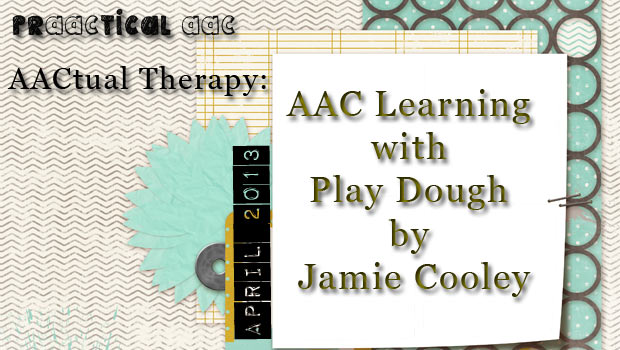
Today, we’re happy to introduce you to another AACtual Therapist, Jamie Cooley, the SLP for Belpre City Schools (belpre.k12.oh.us), located in Belpre, OH. She is a graduate of Ohio University (B.S. ’09, M.A. ’11) and currently resides in Athens, OH. Jamie did work at Ohio University focusing on AAC and children with autism under the instruction of Dr. John McCarthy and Dr. Joann Benigno. She has worked for Belpre City Schools for two years with students in grades K-12. In this post, Jamie uses a case study approach to share a lesson using Play Dough. Background Emma is a third grade student. She was born with hypoplastic left heart syndrome, and her cognitive and communication skills are significantly below age-norms. She receives most of her academic instruction in a resource room. Communicatively, Emma repeats many words and phrases, and combines up to two words on her own. This is... [Read More...]
April 9, 2013
by Robin Parker -
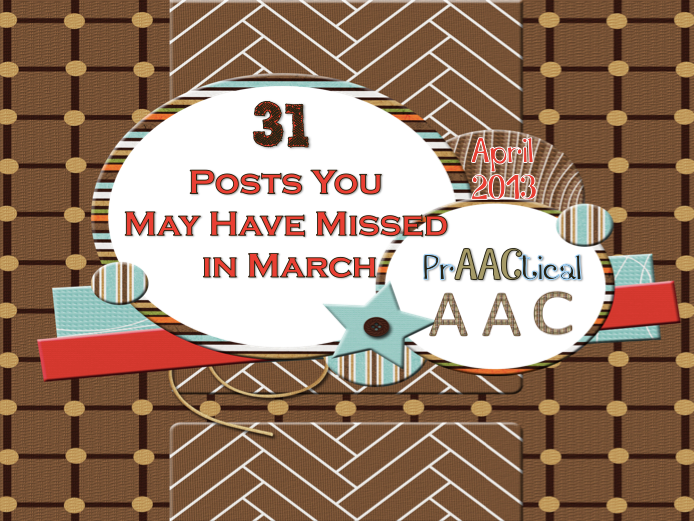
Strategy of The Month Narrative Skills for People with AAC Needs PrAACtical AAC & Personal Narratives Narrative Assessment & People Who Use AAC Let Me Tell You Something: Narratives for the Beginning Communicator Helping People with AAC Needs Develop Personal Narratives PrAACtical Thinking PrAACtical Guessing: 5 APPs for Interactive Inferencing Another Look at Vocabulary Instruction in AAC Magic Moments in Building Vocabulary with ‘Its Cool to be Clever’ It’s PrAACtically Saint Patrick’s Day 28 Posts You May Have Missed in February 10 AAC Things To Do for PrAACtically Free in 10 Minutes of Less Daylight Savings Time & PrAACtical Behavior Another Look At Language Facilitation Strategies to Make AAC Learning Effective Literacy, AT, & Students with Significant Disabilities Watch This: Planning with Strategies Worth Repeating: Big Ideas in Teaching AAC Vocabulary PrAACtical Passover & Easter Supports 30 Things to do During Autism Awareness Month A Beautiful Family, But 1 Question... [Read More...]
April 5, 2013
by Robin Parker -
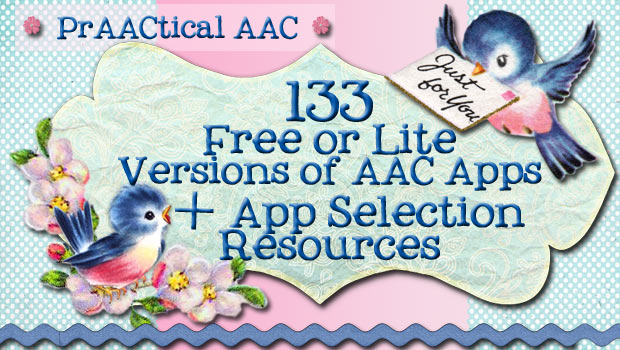
Here is our most recent update of free and lite versions of AAC apps for iOS and Android platform devices + a variety of resources related to AAC app selection. We strongly continue to advocate for a systematic process for AAC app selection. We recommend AAC app decision making in the context of a feature match process that gives appropriate attention to the full range of AAC options. Tools to Use In Making Decisions About AAC Apps Feature match form developed by Jessica Gosnell at Boston Children’s Hospital Feature match checklist created by Scott Marfilius and Kelly Fonner Our supplemental rubric covering language and communication features, RELAAACs Places to Go to Find AAC Apps and Reviews Comprehensive AAC app list for iPhone and iPad by Jane Farrall AAC Tech Connect’s Apps Assistant OCALI’s listing of apps for individuals with ASD Tech in Special Education Aidis Trust Communication App Reviews Training... [Read More...]
April 3, 2013
by Robin Parker -
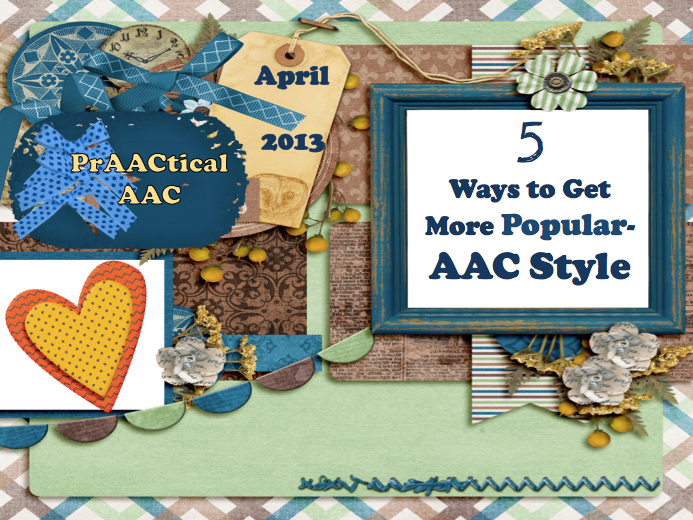
Popularity may or may not be important to children or adults, but most of us would like to have some friends and at least some people we can share information with. From a facilitator’s point of view, we need AAC users to have conversations with a variety of people. The more prAACtice in conversational exchanges the better. We have learned (through research and clinical experience) that if we teach specific skills, communication partners are more likely to initiate and respond to AAC communication. Here are things to teach for ‘conversational’ popularity 1. Teach Partner Focused Questions What’s up? How are you doing? How is your family? How are you feeling? What are you thinking? 2. Teach Social/Participation Scripts Attention Getters Starters Maintainers Turn Transfers Closings Let’s talk. Guess what? And next.. What’s your thoughts? That’s it. Come here. Let me tell you something. want a hint? Amazing right? See you later.... [Read More...]
April 2, 2013
by Robin Parker -
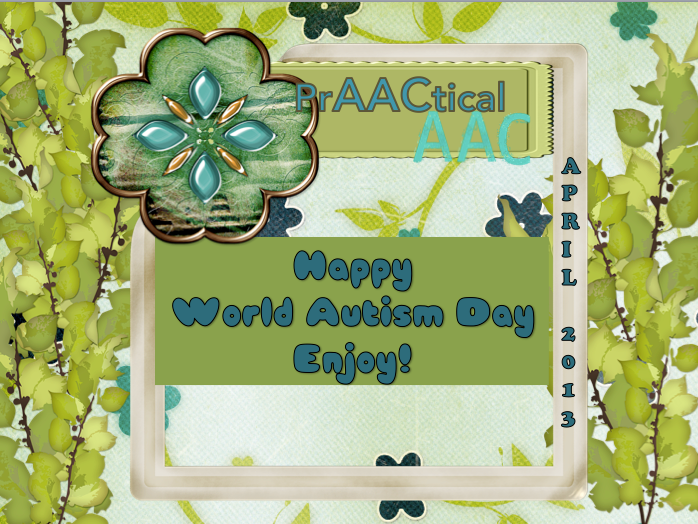
Enjoy! Voices of Autism- The SongStream Project explores the role of music in the lives of four young musicians on the autism spectrum. This project contributes to the conversation about autism beyond statistics and into the domain of appreciation and celebration. AAC Image Links (Great for training and education)- Speak for Yourself – Autism & AAC Awareness (bonus- enter to win Speak for Yourself AAC App) AAC Do’s & Dont’s by Lauren Enders AAC It’s Easy as 1,2,3 by Marcia Sterna World Autism Day Free or Discounted Apps- These are worth checking out! Look for more at the Appy Mall.









